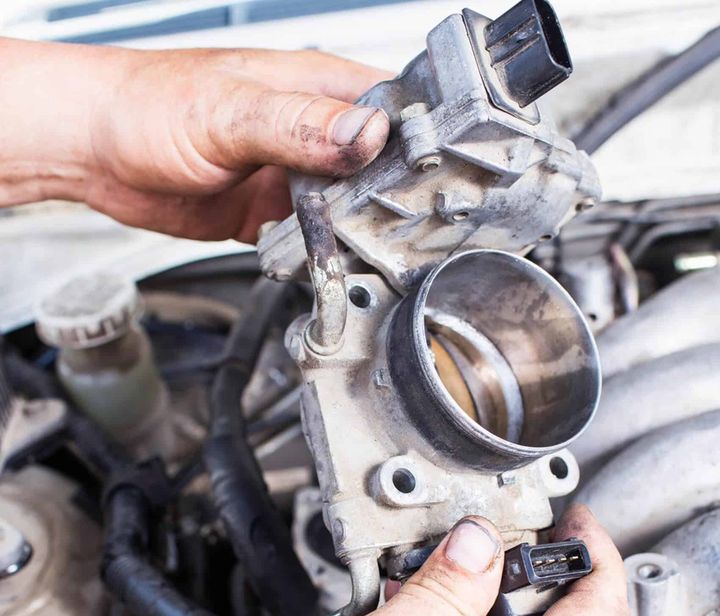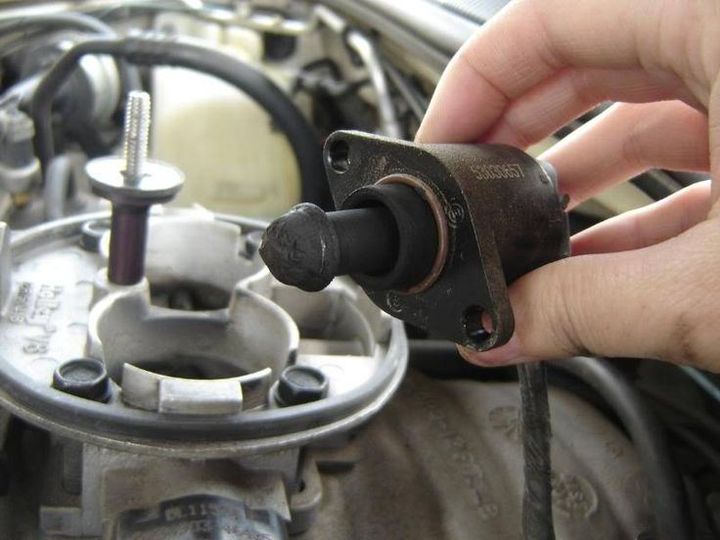


The Idle Air Control (IAC) valve is a crucial component in modern fuel-injected engines. Its primary purpose is to regulate the engine's idle speed by controlling the amount of air that bypasses the throttle plate when the engine is idling or the throttle is closed. This ensures a smooth and consistent idle, preventing stalling or rough idling.

The intake air control valve is a small but mighty component located in the engine's air intake system. Its primary function is to regulate the amount of air entering the engine during idle conditions, ensuring a smooth and consistent idle speed. When the valve becomes clogged or malfunctions, it can lead to a variety of issues, as outlined in the following table:
| Issue | Description |
|---|---|
| Rough Idling or Fluctuating Idle Speed | If the engine's idle speed is erratic or fluctuates significantly, it could be a sign that the IAC valve is not regulating the air flow correctly. |
| Engine Stalling or Difficulty Starting | A clogged or stuck IAC valve can prevent the engine from receiving the proper air-fuel mixture, leading to stalling or hard starting issues. |
| Poor Fuel Economy and Drivability | When the IAC valve is not functioning optimally, it can cause the engine to run inefficiently, resulting in decreased fuel economy and overall drivability. |
| Check Engine Light Illuminated | If the check engine light is on, it's a good idea to have the trouble codes scanned, as they may point to an issue with the idle air control system. |
Over time, the intake air control valve can accumulate carbon buildup and debris, which can impede its proper operation. This buildup is often caused by the natural byproducts of combustion, as well as contaminants present in the air or fuel. Additionally, vacuum leaks or other engine issues can affect the valve's ability to function correctly.
When a customer brings in a vehicle with potential IAC valve issues, my first step is to perform a thorough inspection and diagnosis. This process typically involves:
I'll locate the IAC valve, usually near the throttle body, and check for any visible debris or carbon buildup around the valve. If significant buildup is present, it's a strong indication that the valve needs to be cleaned or replaced.
Listening carefully for any abnormal sounds, such as whistling or hissing, can indicate a problem with the valve or its associated vacuum lines. These sounds can be caused by air leaks, obstructions, or a malfunctioning valve.
I'll inspect the intake manifold and vacuum hoses for any leaks that could be affecting the valve's operation. Vacuum leaks can cause the engine to run lean or rich, leading to various drivability issues and potentially damaging the IAC valve over time.
Using a diagnostic scanner, I'll check for any trouble codes related to the idle air control system. These codes can provide valuable insights into the root cause of the issue and help narrow down the diagnosis.
| Common IAC Valve-Related Trouble Codes |
|---|
| P0505 - Idle Air Control System Malfunction |
| P0506 - Idle Air Control System RPM Lower Than Expected |
| P0507 - Idle Air Control System RPM Higher Than Expected |
| P0508 - Idle Air Control System Circuit Low |
| P0509 - Idle Air Control System Circuit High |
In some cases, I may disconnect the IAC valve and observe the engine's idle behavior to confirm if the valve is the culprit. This test can help rule out other potential issues, such as vacuum leaks or faulty sensors, that may be causing similar symptoms.
Once the issue has been identified, there are two main repair procedures I typically follow:
If the valve is simply clogged or dirty, a thorough cleaning may be all that's needed. Here's the detailed process:
Locate and access the IAC valve, following the vehicle-specific repair manual instructions.
Disconnect the negative battery cable to prevent any electrical issues.
Remove the valve from the intake manifold or throttle body.
Use a throttle body cleaner or carburetor cleaner to spray and soak the valve, allowing the cleaner to penetrate and dissolve the carbon buildup.
Agitate the valve with a soft brush or compressed air to dislodge any stubborn deposits.
Rinse the valve thoroughly with clean water or brake cleaner to remove any remaining cleaner residue.
Dry the valve completely using compressed air or a clean, lint-free cloth.
Inspect the valve for any signs of damage or excessive wear. If the valve appears excessively worn or damaged, replacement is recommended.
Reinstall the cleaned valve with a new gasket if needed, ensuring proper orientation and connections.
Reconnect the battery and start the engine to verify proper operation.
In some cases, the valve may be too damaged or worn to be effectively cleaned, necessitating replacement. The process is similar to cleaning, but with a few additional steps:
Follow the removal process outlined above.
Install the new IAC valve, ensuring proper orientation and connections.
Reconnect the battery and start the engine.
Perform any necessary idle air relearning procedures, as specified by the vehicle manufacturer.

As with most automotive components, prevention is key when it comes to the intake air control valve. Here are some tips to help prevent future issues:
Regular Maintenance: Follow the recommended service intervals for cleaning and inspecting the intake system components, including the IAC valve.
Use High-Quality Fuel: Using high-quality fuel can help reduce the buildup of contaminants and deposits in the engine's air intake system.
Address Underlying Issues: If any vacuum leaks or other engine problems are detected, address them promptly to prevent further complications.
Consider Fuel System Cleaners: Periodically using a reputable fuel system cleaner can help remove deposits and keep the entire system running smoothly.
| Recommended Maintenance Schedule | |
|---|---|
| Every 30,000 miles or 2 years | Inspect and clean the IAC valve |
| Every 60,000 miles or 4 years | Replace the IAC valve (if necessary) |
| As needed | Use fuel system cleaner |
When it comes to the cost of cleaning or replacing the IAC valve, there are a few factors to consider:
| Cost Factor | Typical Range |
|---|---|
| Parts Cost (New IAC Valve) | $50 - $200 |
| Labor Cost (Professional Mechanic) | $80 - $200 |
| DIY Cost | Cost of replacement part (if needed) and any necessary tools or cleaning supplies |
It's important to address IAC valve issues promptly, as a faulty valve can lead to further engine problems and decreased fuel efficiency if left unresolved.
The intake air control valve may be a small component, but its impact on engine performance and efficiency is significant. As a mechanic, I've seen firsthand the issues that can arise when this valve is neglected or malfunctioning. By understanding the importance of regular maintenance and addressing any issues promptly, you can help ensure your vehicle runs smoothly and efficiently for years to come.
Remember, preventive maintenance is key, and seeking the expertise of a qualified mechanic can save you time, money, and frustration in the long run. So, the next time you notice any signs of a potential IAC valve issue, don't hesitate to have it checked out – your engine (and wallet) will thank you.
The IAC valve regulates the amount of air bypassing the throttle plate during engine idling. It helps maintain a consistent and smooth idle speed by adjusting the air-fuel mixture.
Yes, a clogged or malfunctioning IAC valve can cause the engine to run inefficiently, resulting in decreased fuel economy and increased emissions.
It's recommended to inspect and clean the IAC valve every 30,000 miles or 2 years as part of regular maintenance.
A stuck IAC valve can cause symptoms like a very high or very low idle speed, difficulty starting the engine, and stalling issues.
While it's possible to drive with a faulty IAC valve, it's not recommended as it can lead to further engine problems and decreased fuel efficiency.
Common tools needed include a throttle body cleaner, a soft-bristle brush, compressed air, and a clean cloth or rag.
In some cases, it may be possible to clean the IAC valve without removing it by spraying cleaner directly into the valve opening. However, removal is often recommended for a more thorough cleaning.
If the IAC valve is excessively worn or damaged, it's recommended to replace it with a new one to ensure proper operation.
Yes, a malfunctioning IAC valve can trigger various trouble codes related to the idle air control system, which can illuminate the check engine light.
Using high-quality fuel, addressing any vacuum leaks or engine problems promptly, and considering fuel system cleaners can help prevent IAC valve issues.

Sarah isn't your average gearhead. With a double major in Mechanical Engineering and Automotive Technology, she dived straight into the world of car repair. After 15 years of turning wrenches at dealerships and independent shops, Sarah joined MICDOT to share her expertise and passion for making cars run like new. Her in-depth knowledge and knack for explaining complex issues in simple terms make her a valuable asset to our team.











